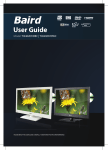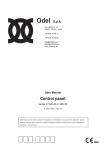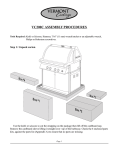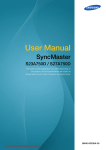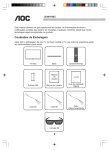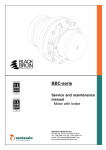Download Manual - 24 3D LED TV BAIRD new design ver1.indd
Transcript
A3./=-<//8 User Guide Model: TI24013DBR Please read this Manual carefully before using this product and retain for future reference. 2 CONTENTS Important Safety Instructions . . . . . . . . . . . . . . . . . . . . . . . . . . . . . . . . . . . . . . . . . . . . . . . . . . . . . . . . . . 4-5 What is included in the box . . . . . . . . . . . . . . . . . . . . . . . . . . . . . . . . . . . . . . . . . . . . . . . . . . . . . . . . . . . . 6 Attaching/Detaching the stand and wall mounting . . . . . . . . . . . . . . . . . . . . . . . . . . . . . . . . . . . . . 7 Getting Started - Initial Set Up . . . . . . . . . . . . . . . . . . . . . . . . . . . . . . . . . . . . . . . . . . . . . . . . . . . . . . . . . 8 TV Buttons and Input Source Menu . . . . . . . . . . . . . . . . . . . . . . . . . . . . . . . . . . . . . . . . . . . . . . . . . . . . 9 Remote Control . . . . . . . . . . . . . . . . . . . . . . . . . . . . . . . . . . . . . . . . . . . . . . . . . . . . . . . . . . . . . . . . . . . . . . . 10 Connections . . . . . . . . . . . . . . . . . . . . . . . . . . . . . . . . . . . . . . . . . . . . . . . . . . . . . . . . . . . . . . . . . . . . . . . . . . 11-12 TV Menu Operation . . . . . . . . . . . . . . . . . . . . . . . . . . . . . . . . . . . . . . . . . . . . . . . . . . . . . . . . . . . . . . . . . . . 13-19 Channel Menu . . . . . . . . . . . . . . . . . . . . . . . . . . . . . . . . . . . . . . . . . . . . . . . . . . . . . . . . . . . . 13 Picture Menu . . . . . . . . . . . . . . . . . . . . . . . . . . . . . . . . . . . . . . . . . . . . . . . . . . . . . . . . . . . . . . 14 3D Mode . . . . . . . . . . . . . . . . . . . . . . . . . . . . . . . . . . . . . . . . . . . . . . . . . . . . . . . . . . . . . . . . . . 15 Sound Menu . . . . . . . . . . . . . . . . . . . . . . . . . . . . . . . . . . . . . . . . . . . . . . . . . . . . . . . . . . . . . . 16 Time Menu . . . . . . . . . . . . . . . . . . . . . . . . . . . . . . . . . . . . . . . . . . . . . . . . . . . . . . . . . . . . . . . . 17 Lock Menu . . . . . . . . . . . . . . . . . . . . . . . . . . . . . . . . . . . . . . . . . . . . . . . . . . . . . . . . . . . . . . . . 18 Setup Menu . . . . . . . . . . . . . . . . . . . . . . . . . . . . . . . . . . . . . . . . . . . . . . . . . . . . . . . . . . . . . . . 19 PC Operation. . . . . . . . . . . . . . . . . . . . . . . . . . . . . . . . . . . . . . . . . . . . . . . . . . . . . . . . . . . . . . . . . . . . . . . . . . 20-21 8 Day TV Guide . . . . . . . . . . . . . . . . . . . . . . . . . . . . . . . . . . . . . . . . . . . . . . . . . . . . . . . . . . . . . . . . . . . . . . . . 22 USB Record . . . . . . . . . . . . . . . . . . . . . . . . . . . . . . . . . . . . . . . . . . . . . . . . . . . . . . . . . . . . . . . . . . . . . . . . . . . 23 Media Mode . . . . . . . . . . . . . . . . . . . . . . . . . . . . . . . . . . . . . . . . . . . . . . . . . . . . . . . . . . . . . . . . . . . . . . . . . . 24 General Information . . . . . . . . . . . . . . . . . . . . . . . . . . . . . . . . . . . . . . . . . . . . . . . . . . . . . . . . . . . . . . . . . . . 25-26 Frequently Asked Questions . . . . . . . . . . . . . . . . . . . . . . . . . . . . . . . . . . . . . . . . . . . . . . . 25 Technical Specifications . . . . . . . . . . . . . . . . . . . . . . . . . . . . . . . . . . . . . . . . . . . . . . . . . . . 26 3 IMPORTANT SAFETY INSTRUCTIONS Please read these instructions. All the safety and operating instructions should be read before the appliance is operated. Warnings • To reduce the risk of fire, electric shock or damage to the television, do not expose it to dust, rain or moisture, or place any objects filled with liquids on or near the television. • Do not place the television in a confined space, ensure that nothing can obstruct the ventilation openings at the rear of the television. Dispose of this television and any components including batteries in an environmentally friendly manner. If in doubt, please contact your local authority for details of recycling. To prevent spread of fire, keep candles or other open flames away from this product at all times Safety • For your safety, this appliance is fitted with a fused moulded 3 pin mains plug. Should the fuse need to be replaced, ensure that any replacement is of the same amperage and approved with the BSI mark. • The television should be connected to a mains socket outlet with a protective earthing connection. • Never try and replace the mains plug unless you have adequate qualifications and are legally authorised to do so. In the event that a replacement Mains cable is required, contact the manufacturer for a suitable replacement. • Never use the television if it is damaged in any way. • Always place the television on a flat level surface avoiding anywhere which may be subject to strong vibration. • Ensure the television is not placed on top of the power cable as the weight of the television may damage the cable and cause a safety hazard. • Never place mobile phones, speakers or any other device which may cause magnetic or radio interference close the television. If interference is apparent, move the device causing the interference away from the television. • To disconnect the apparatus from the mains, please disconnect the Mains Adaptor from the wall socket. Always ensure the switch on the wall socket is readily accessible. • Batteries (battery pack or batteries installed) shall not be exposed to excessive heat such as sunshine, fire or the like. • Install the product at least 5cm from the wall for ventilation. Maintenance • To clean this unit, wipe with a soft, dry cloth. If the surfaces are extremely dirty, use a moist soft cloth dipped in a soap and water solution or a weak detergent solution. • Use eyeglass cleaner to carefully remove stubborn dirt from the LCD/LED Screen. • Never use alcohol, paint thinner or benzene to clean this unit. • Before using a chemically treated cloth, read the instructions that came with the cloth carefully. CAUTION: If water or other liquid enters the television through the display panel surface, a malfunction may occur. Packaging • The safest way to transport your item is in the original box/packaging - please save your packaging for this purpose. • You will need the original box/packaging in the event of warranty/service repair or support. We are unable to carry out warranty/service if you are unable to package it correctly. 4 IMPORTANT SAFETY INSTRUCTIONS Please read these instructions. All the safety and operating instructions should be read before the appliance is operated. Important Information Regarding Use of Video Games, Computers, Captions or Other Fixed Image Displays The extended use of fixed image material can cause a permanent “shadow image” on the LCD panel. This background image is viewable on normal programmes in the form of a stationary fixed image. This type of irreversible LCD/LED panel deterioration can be limited by observing the following steps: 1. Reduce the brightness/contrast setting to a minimum accetable viewing level. 2. Do not display a fixed image for extended periods of time. 3. Turn the power off when not in actual use. Examples of images that you need to watch out for are as follows (this is not an exhaustive list): • TV Channel Logos: e.g. Shopping channel logos and pricing displays-especially if they are bright and stationary. Moving or low-contrast graphics are less likely to cause ageing of the screen. • Time Displays • Teletext: Do not view a stationary page for a long period of time • TV/DVD Menus: e.g. Listings of DVD disk content • Pause Mode: Do not leave the TV in pause mode for long periods of time, e.g. When watching DVDs or videos. Important: Once a ‘shadow image/screen burn’ occurs, it will never disappear and is not repairable under warranty. How do I dispose of this product? UK: Waste electrical products should not be disposed of with household waste. Separate disposal facilities exist. For your nearest facilities, contact your local council for information on your nearest disposal site. ROI: Waste electrical products should not be disposed of with household waste. Separate disposal facilities exist. Check with your Local Authority or retailer for recycling advice. Batteries • • • • • 5 Observe the correct polarity when inserting batteries. Do not use different types of batteries together or mix old and new batteries. Dispose of batteries in an environmentally friendly way. Certain regions may regulate the disposal of batteries. If you are not using your TV for an extended period of time then remove the batteries to prevent possible damage due to leakage. Many Stores provide battery recycling points. If in doubt contact your local authority. Cd WHAT IS INCLUDED IN THE BOX Accessories Included with this TV are the following accessories: 1 x User Guide 1 x Remote Control 2 x AAA Batteries 1 x Mini YPbPr Cable 1 x TV Stand Fixing Screws 2 Pairs of 3D glasses A3./=-<//8 User Guide Model: TI24013DBR Please read this Manual carefully before using this product and retain for future reference. 1 x Quick Start Guide QUICK START GUIDE Easy 6 step installation Please read the section on SAFETY before proceeding with your installation. Thank you for purchasing this Baird TV. Remove the TV from the packaging and follow these simple steps to quickly start using your television. To fully understand the features and safety advice of your LED TV, we strongly recommend that you read the enclosed manual thoroughly. 1 Insert the Stand Base into the bottom of the LED TV body and tigten the screws. 4 2 3 Insert the aerial cable into the RF socket. 5 6 Power indicator Insert two UM-4 (AAA) batteries into the remote control. Take care to observe correct polarity. Connect the power cord to the Adaptor and the output of the adaptor to the TV DC IN Socket, then plug the other end of the power cord into a suitable wall socket. Switch on the power to the TV. Switch on the TV by pressing the power button on the top of the TV or on the remote control. (The LED will change from red to green) The screen will light up after about 5 seconds and the FIRST TIME INSTALLATION will come on the screen. Check the OSD Language and Country are set to “English” and “UK respectively. Use the arrow RIGHT and LEFT buttons to change if necessary. Press “OK” to confirm. Auto Tuning will start, this will take a few minutes. On completion the TV will store all DIGITAL TV and RADIO Programmes available in your area and then display the first Channel found which is normally BBC1. For all other Setup Information please refer to your User Manual. 1 x Bottom Stand 1 x Mains Adapter / Power cord Please save your packaging as you will need this in the event of warranty/service repair or support. We are unable to carry out warranty/service if you are unable to package it correctly. The safest way to package your item in the event of warranty/service repair is in it’s original box/packaging. What is included in the box 6 ATTACHING / DETACHING THE STAND Attaching the Stand Base Place the TV face down on a protective surface. To attach the stand, insert the neck of the TV stand into the socket of the stand plate and tigten the screws. Detaching the Stand To remove the stand, remove the screws in the circled area and the neck will come off. IMPORTANT - Before drilling any holes in the wall ensure you are not drilling where there could be any electric wires, water or gas pipes. Wall mounting the TV This television requires a VESA 100 x 100 wall mount, or equivalent. 1) Your TV is provided with four hexagonal spacers to attach your wall mount. 2) The wall mount can now be easily attached to the spacers using suitable screws. The positions of the spacers is indicated in the diagram below. fig 1 TV fig 2 Viewing angle TV Viewing angle For optimum viewing, if wall mounting the TV higher than eye level, the TV should be tilted downwards so that the TV’s screen is ‘face on’. See fig 1 and 2 Important – If wall mounting this TV, only use the spacers already provided in the wall mounting holes. Using other screws which are longer could cause irreparable damage to internal parts. 7 Important installation instructions GETTING STARTED - INITIAL SET UP 1) Using the RF cable supplied, connect the TV to the TV Aerial wall socket (Fig A) 2) Connect the power cable to the Mains Adaptor and the Mains Plug to the wall socket. Ensuring the wall socket is OFF, connect the DC Output of the Adaptor to the TV “DC IN” connector.(Fig B) Fig A Fig B 3) Switch on the switch on the wall socket. 4) Insert the batteries supplied into the Remote control and press the Standby button to power on the TV. Take care to observe correct polarity. 5) You will now be welcomed with the initial set-up screen. If it does not appear, on the remote control, please press [MENU] then 8-8-8-8 and the menu will appear. Press OK to confirm OSD LANGUAGE and again to confirm the Country as UK. Then press OK again and the auto tuning will start. 6) After tuning the following screen will appear. Press OK to confirm Country Code, again to confirm Primary region and twice more to confirm Secondary and Tertiary Regions. Your first Programme should now appear. Please select an OSD Language First Time Installation OSD Language English Country UK Auto Tuning English Español Italiano Deutsch Français Nederalnds OK Tip: If the TV finds some, but not all, of the Digital channels, the TV is functioning correctly but the signal being received is not strong enough. (The signal strength needs to be above 85% - you can see the signal strength the TV is receiving when you change channels/ programmes) you will need to increase the signal reception in order to receive all of the channels available. The most economical way to do this is by purchasing and connecting a ‘signal booster’ in between the TV and the TV aerial socket. If this does not solve the problem, you will need to upgrade the TV aerial to a digital hi-gain compatible aerial Connect between TV and TV aerial socket Signal Booster Getting Started - Initial Set Up 8 TV BUTTONS & SOURCE MENU 1 Volume up and Volume down 2 Menu left and menu right 3 Displays the input source menu 4 Standby Power On/Off 5 Remote sensor - Infrared sensor for the remote control. 6 Power indicator - Red is standby mode, green when your TV is switched on. 1. 2. 3. 4. Remote sensor 5. Power indicator 6. Choosing Mode Input/Source To switch between the different input/connections. A) Using the buttons on the remote control: 1) Press [SOURCE] - The source menu will appear 2) Press [\/] or [/\] to select the input you require. 3) Press [OK] B) Using the buttons on the Television: 1) Press [SOURCE] 2) Scroll up / down using CH+/ CH- buttons to the input/ source you require 3) Press Vol+ to change input/source to the one selected. 9 TV Buttons and Source Menu REMOTE CONTROL 1 STANDBY MUTE 2 NUMBER BUTTONS 0 – 9 to select a TV channel directly. REC LIST Opens the list of Programmes you have previously recorded To return to the previous channel viewed EPG Opens the 8 Day TV Guide (Digital TV mode) SUBTITLE AUDIO 3 DISPLAY Switch on TV when in standby or vice versa Mute the sound or vice versa MENU EXIT To display the OSD menu To exit all menus VOL FAV To increase / decrease the sound level Displays Favourites list. To Record the programme being currently viewed. Switch to MEDIA (USB) source To change (UP or DOWN) the Channel Number currently being viewed To display the input/source menu MEDIA CH SOURCE 5 2 To switch the dialogue at the bottom of the screen (on/off ) Switches audio output from L - R and Mono Stereo Displays Now and Next information on the Channel being currently viewed. TV/RADIO Switch between TV and radio in Digital TV mode Allows you to navigate the on-screen menus and adjust the system settings to your preference 4 1 P.MODE S.MODE SLEEP Scrolls through picture mode options Scrolls through sound mode options Press repeatedly to cycle through the sleep options TEXT To enter Teletext mode HOLD Teletext mode - Hold current page which is displayed REVEAL Teletext mode - To reveal or hide the hidden words SUBPAGE Sub coded page access. TIMESHIFT In DTV mode, press to execute the time shift function. INDEX To display the index page SIZE Alters the text size in Analogue TV Mode only. To play/pause To stop the playback To play in fast rewind mode To play in fast forward mode To restart the current chapter To advance forward to the next chapter 3 4 5 Only operates when a compatible USB device is connected COLOURED BUTTONS For navigating as prompted on screen Remote Control 10 CONNECTIONS 1 DC IN 12V 4A 2 Headphones out Connect Headphones 3 PC Audio Connect the PC Audio VGA IN Connect the PC-RGB / Audio output jack of PC. 4 Y/Pb/Pr Connect the Y/PbPr output jack of DVD or VCR. 5 SCART Connect the SCART jack of VCR or DVD. 6 VIDEO IN Connect the Video output jack of DVD or VCR. 7 Audio (L/R) Connect the Audio of the DVD or VCR. 8 Coaxial Audio Out Connect the Coaxial Digital Audio Out from your DVD or other compatible device. 9 RF Connect the RF Cable 10 HDMI Connect the HDMI output jack of DVD/ Bluray player etc. 11 USB Connect to a portable USB device. 12 CI (Common Interface) Connect to the CI card. (Not Supplied) REAR OF TV: SIDE OF TV: Connecting a DVD Player/Recorder, Video Recorder or Cable/Satellite Box TVs Input/Source should be set to SCART RF IN DVD or VCR TV Aerial Wall Socket SCART OUT RF IN RF OUT SCART 11 Connections CONNECTIONS Connecting a Camcorder, Camera or Games Console Source should be set to AV Camera or Camcorder Yellow Video White Audio In L/R Red Connecting a High Definition (HD) Device Option 1 - via HDMI to HDMI cable A HDMI cable can output both video and audio and enables you to enjoy digital-quality video and audio with minimal loss of quality. TVs Input/Source should be set to HDMI. HDMI OUT HDMI Option 2 - via Component cable If you are supplied with a cable from the device which has RED, GREEN, BLUE, RED & WHITE connectors you must connect via Component (for picture) and by phono cable (for sound). Your TV is supplied with a 3.5mm jack to 3 x RCA sockets to enable you to use a 3 x RCA lead (not supplied) to connect to the component output of your device. TV Source should be set to YPbPr Component (HD) Red Green Blue Audio L/R Component Red White Audio In L/R Connecting a hi-fi system / sound amplifier For best results connect your Amplifier to the Coaxial Audio Out of your TV. Alternatively you can connect your Headphone Output to your Amplifier. Ensure that this does not exceed the maximum allowable input level of your device. Neither of the above leads are supplied with your television. L R Connections 3.5mm jack headphones output 12 CHANNEL MENU To access this menu, press [MENU] button on the remote control. To enter a menu press [OK] If you wish to make changes to any of the default settings, use the scroll settings press [OK] button. buttons. To confirm any To exit this menu at anytime, press [EXIT] button. Auto Tuning - Allows you to retune the television for all digital channels, digital radio stations and analogue channels. DTV Manual Tuning- Allows you to manually tune your digital signal Programme Edit - Allows you to delete, skip and add favourite channels. Schedule List - Allows you to select Schedule List - auto search Signal Information - Allows you to display signal details, including Channel, Quality and Strength. CI Information - Allows you to display details after you have inserted the CI card. 13 TV Menu Operation PICTURE MENU To access this menu, press [MENU] button on the remote control. To enter a menu press [OK] If you wish to make changes to any of the default settings, use the scroll To confirm any settings press [OK] button. buttons. Tip: Only the “Personal” mode allows you to adjust Contrast, Brightness and Colour. To exit this menu at anytime, press [EXIT] button. Picture Mode - Choose from the following presets Standard Default settings Dynamic Provides higher levels of Contrast and brightness. Mild Set to be lighter in colour and less bright Personal Lets you manually alter all the settings Contrast - Switch the balance between black and white Brightness - Increase or decrease the brightness of the picture Colour - Increases the colour saturation Tint - Lets you increase or decrease the level of tint within the picture. (only in NTSC playback mode) Sharpness - Increase or decrease the sharpness of the picture Colour Temperature - Choose from the following presets Normal Default settings Warm Increases red within the picture Cool Increases blue within the picture 3D Setup - Available 3D Format Options: Off, Side by Side, Line by Line, Top Bottom, Frame Packing Not available in DTV, only in media/PC/ HDMI mode. Noise Reduction - Choose from the following presets Off Turns noise reduction off Low Minor system adjustment Middle Medium system adjustments High Maximum system adjustments Default Default settings Tip: If you do not press any buttons for 10 seconds, the menu will automatically exit. You can change the length of time before the menu exits automatically - see ‘Menu Duration’ section. TV Menu Operation 14 3D MODE 3D Viewing Safety Viewing 3D images through a television and 3D glasses 3. Press ‘ play’ on your 3D source to start playing the 3D content, the image you will see on your screen will affects different people in different ways. Please read be fuzzy. and understand the safety warnings in the ‘safety The TV may automatically select the correct 3D information’ section of this manual before operating mode for playing your content, but this is dependent this television in 3D mode. upon your 3D source. If it does not display correctly, What is 3D refer to point 5 and manually select ‘framepacking’ 3D imaging uses a process known as stereography mode, (this is generally the default for the UK). to generate the perception of a 3 dimensional image 4. Put on the 3D glasses for 3D effect from a pair of 2 dimensional images. Each stereograph 5. Select “3D Type” option in the PICTURE menu and image pair contains a specific image for the viewer’s you will see a box in the left eye and another image of the same scene, from a top left hand corner of slightly different angle for the viewer’s right eye. The your television screen slight variations between the left and right images that shows you the of the same scene will ‘trick’ the viewer’s brain into 3D mode that your constructing a 3 dimensional image just as it would television is in. process a normal image from both eyes. The 3D System used in this TV is the passive type which menas the Pressing the button on your remote control will glasses provided do not require batteries to provide show you more options for the dierent types of 3D your 3D experience. mode. (Available 3D Type: Connecting a 3D Source Off,Side by Side,Line by A 3D source is required in order for you to be able Line, Top Bottom,Frame to view 3D images on your television. A 3D bluPacking) Select the ray player(with a 3D disc) connected using a 1.4 ‘Frame Packing’ 3D HDMI cable or 3D transmission directly to your TV is Mode( this is generally necessary to allow you to view 3D images. Your 3D the default for UK content). television will not produce 3D images unless it has a 6. 3D mode has now been enabled on your television . 3D source and it will not produce 3D images from 2D At this point you should put on your 3D glasses . content. If viewing 3D content directly from a television transmission, follow steps 3 to 5 above to enable the Enabling 3D mode on your Television correct 3D mode and begin viewing. Do not enable 3D mode on your television or use your 3D glasses in 2D mode otherwise you will see a distorted image. Using your 3D glasses There are 2 pairs of linear polarized 3D glasses supplied To enable 3D mode on your television, ensure that you with this television. Linear polarized glasses require have already been through the initial set up process as you to maintain your head in a vertical position. Tilting your head left to right can break the 3D effect outlined in this manual. because the content relies on one eye seeing the vertically polarized image and the second eye seeing To view 3D content: the horizontally polarized image. When the head is 1. Connect your 3D source (such as a BLU-RAY player) to the HDMI connection using a 1.4 HDMI cable. Turn tilted the polarized lenses are no longer in line with the double image on the screen. your 3D source on. 2. Press the input button on 3D Viewing Guidelines your remote control and For the best 3D viewing experience stay within the select the relevant HDMI viewing angle and at the optimum distance from your connection from the drop television. down menu as shown in Ensure that there are no obstacles between the 3D fig.1. glasses and the television. Viewing of 3D images on your television may be • Press ▼/▲ button to select the HDMI connection for affected by fluorescent lights or direct sunlight. Please your 3D source; ensure that fluorescent lighting is switched off and • Press OK/ ► button to enter the input source; sources of direct sunlight are blocked before viewing • Press OK button to enter the input source; 3D content. 15 TV Menu Operation SOUND MENU AD switch 50 To access this menu, press [MENU] button on the remote control. To enter a menu press [OK] If you wish to make changes to any of the default settings, use the scroll settings press [OK] button. buttons. To confirm any To exit this menu at anytime, press [EXIT] button. Sound Mode - Choose from the following presets Standard Default settings Music Emphasises music over voices Movie Provides live and full sound for movies Personal Selects your personal sound settings Sports Emphasises sound for sports Tip: Treble and bass levels can only be adjusted when the sound mode ‘Personal’ is selected. Treble - To adjust the amount of high frequency within the sound Bass - To adjust the amount of low frequency within the sound Balance - To switch the sound between the left and right speakers Auto Volume Level (AVL) - When ‘on’ is selected, the volume will stay at a constant level regardless of input/ source SPDIF Mode - This is the digital COAX Audio output. Choose from the following options: Off Off Auto Selects the best settings automatically PCM Select this option if you are connecting to a Stereo Hi-fi via coax cable (Pulse-code modulation (PCM) is a digital representation of an analogue signal) AD Switch - Increase or decrease the volume level of the Audio Descriptor when this feature is activated. TV Menu Operation 16 TIME MENU To access this menu, press [MENU] button on the remote control. To enter a menu press [OK] If you wish to make changes to any of the default settings, use the scroll settings press [OK] button. buttons. To confirm any To exit this menu at anytime, press [EXIT] button. Clock - Set the date and time Tip: If you are receiving a Digital TV signal your date and time will be set automatically and this function will be greyed out. Time Zone - Change your current time zone Sleep Timer - Lets you set the sleep timer so the television automatically switches off after a set amount of time. Off -> 10min -> 20min -> 30min -> 60min -> 90min -> 120min -> 180min -> 240min Auto standby - Toggle the Function between OFF, 3, 4 or 5 hours. NOTE: The default setting is OFF. OSD Timer - Available options are: 5S, 10S,15S ,20S, 25S, 30S. 17 TV Menu Operation LOCK MENU To access this menu, press [MENU] button on the remote control. To enter a menu press [OK] If you wish to make changes to any of the default settings, use the scroll settings press [OK] button. buttons. To confirm any To exit this menu at anytime, press [EXIT] button. Lock System - Press OK button to make the following 3 options valid (Default password is ‘0000’). Password - Press OK button to enter sub-menu to set a new password. Block Programme - Press OK button to enter the sub-menu. On the Block programme submenu: Press ▼/▲ button to select the programme you want to lock, then press the green button on your remote control (To unlock the programme, input the password you set), press OK button to save setting and menu button to back go to the previous menu. Parental Guidance - Press OK. Enter sub-menu to select viewing settings, available options are: Off, 4-18. Key Lock - Enter sub-menu to select the lock settings, available options are: On, Off. TV Menu Operation 18 SETUP MENU To access this menu, press [MENU] button on the remote control. To enter a menu press [OK] If you wish to make changes to any of the default settings, use the scroll settings press [OK] button. buttons. To confirm any To exit this menu at anytime, press [EXIT] button. OSD language - Allows you to change the language of the menu TT Language - TT Language in SETUP is invalid. Audio Language - Allows you to select Audio Language. Subtitle Language - Allows you to select Subtitle Language. Hearing Impaired - Press OK button to select on or off. PVR File System - Press OK button to enter sub-menu. Aspect Ratio - Within the UK the picture format varies depending on the channel/broadcast. There are a number of different options to best meet your needs Auto Automatically displays the best picture format. So the picture is in the correct position. May have black lines At the top/bottom and/or sides. 4:3 Original Displays the 4:3 picture in its original size. Side bars are shown to fill the 16:9 screen Will display the picture from the broadcaster without any change Zoom 16:9 The picture is the correct proportion but zoomed in to fill the screen Top and bottom bars are shown to fill the 16:9 screen. 4:3 pictures will be stretched Blue Screen - Changes the background when there is no input between clear and a blue background (Only available on some sources) Reset to default Reset Menu System - This resets the menus to factory settings. Reset TV Channels - This clears all the TV channels from the television and the Menu settings. Software Update (USB) - From time to time we may release new firmware to improve the operation of the television (available to download). This menu lets you install the new software/firmware onto the television. Further details of how to do this will be issued with the firmware. Contact the helpline or refer to the ‘product support’ section of the website. 19 TV Menu Operation USING THE TELEVISION AS A COMPUTER MONITOR IMPORTANT – Before connecting the computer to the television you must ensure the computer settings are correct for the television. You MUST do this using your old monitor. How to set up for Windows XP, Windows Vista & Windows 7 (connecting via VGA cable to the TV) 1) Switch on your computer Windows XP Windows Vista Windows 7 2) When finished booting up right click your mouse anywhere on the screen 3) Left click your mouse on Properties/ Personalise 4) Left click your mouse on Setting/Display Settings. Ensure the screen resolution is set to what is shown in the technical specifications section toward the rear of this user guide. To correct the resolution to that of the television move the slider. 5) Left click your mouse on Advance/ Advanced Settings and left click on Monitor 6) Left click on the drop down for Screen refresh rate and select 60 Hertz, if you experience picture noise or ‘flickering’, select 50 hertz or 70 hertz. 7) Click on Apply, then click Yes and the settings will be saved. 8) Now switch off your computer and connect the television (as shown) 9) Switch on the TV, select the input/source to VGA/PC and re-start your PC. Connecting a Laptop In addition to the above if you are connecting a laptop to the television you will also need to activate the VGA connection on the laptop. This can vary based on the brand of laptop you have, on many brands/models, it is as per below. 1) Connect the laptop to the television 2) On the Laptop push buttons The screen will now switch to the television. PC Operation 20 PC SETTINGS To access this menu, press [MENU] button on the remote control. To enter a menu press [OK] If you wish to make changes to any of the default settings, use the scroll settings press [OK] button. buttons. To confirm any To exit this menu at anytime, press [EXIT] button. Auto Adjust - Lets you automatically configure the television to be used as a computer monitor. It is recommended that you use this feature first as in most cases it will correctly align the picture. H Offset - Changes the horizontal position of the picture V Offset - Changes the vertical position of the picture Size - increase picture size Phase - To adjust delay time of phase in order to reduce the noise of picture Position Reset - Changes back to the original settings Tip: If the computer is left in-active for a period of time, the television will switch into a ‘sleep’ state (the screen will power off to save power). To switch back on press the standby button. 21 PC Operation 8 DAY TV GUIDE / USB RECORD The TV Guide is available in Digital TV mode. It provides information about forthcoming programmes (where supported by the Digital TV channel). You can view the start and end time of all programmes and on all channels for the next 8 days and set reminders. 1) Press [TV GUIDE]. The following 8 Day TV Guide will appear. 2) Navigate through the menu using You can now: Record a Programme by pressing RED Set a reminder by pressing GREEN View a previous day by pressing YELLOW View the next day by pressing BLUE 3) Press [EXIT] to exit the 8 day TV Guide. 4) Remind This function will remind you that when the programme is about to start. Press the Green button twice to select to Once, Every day, Every week or Auto. Note: This TV is designed to operate with USB memory sticks up to 32GB. It is possible to use either a USB memory stick or a USB portable Hard Drive of a larger capacity, however, it must be formatted to the FAT32 file system in order to operate correctly. At the time of printing this user guide, Windows XP/Vista computers are only capable of formatting up to 32GB, therefore, you will need a software programme/utility to format larger USB drives/hard drives to FAT32. Additional help and support is available from the web site. 8 Day TV Guide 22 USB RECORD - DIGITAL/DIGITAL TV MODE USB RECORD – DIGITAL/Digital TV MODE Built into this television is a USB record facility. This function is available in Digital/Digital TV mode when used in conjunction with a compatible USB memory stick or USB Hard drive. The benefits of this are as follows: • Pause live TV/Radio and then playback, fast forward and rewind (up to live TV) • One button record, if you decide you want to record the current programme • Easy programmemable recording from the 8 day TV Guide • Record TV/Radio and watch/listen back on your computer/laptop Due to the nature of the product, it is necessary to use a high speed USB memory stick (as the TV reads from and writes to the memory stick at the same time, some memory sticks may not be suitable) You can purchase a suitable USB device form a Computer store or On Line. See below for the minimum specification. Minimum Specification - USB Memory Stick Read Speed 20 MB/s (Mega Byte Per Second) Write Speed 6 MB/s (Mega Byte Per Second) If you wish to use a USB portable hard drive larger than 32GB, please refer to the FAQ section at the rear of this user guide. Pause Live TV/Radio (Time Shift) Pausing Live TV/Radio is very simple. - Press the play/pause (Timeshift) button and the television will pause and the live content will be recorded. To resume watching press play/pause again. - Press fast forward to go forward in a recording (i.e. to skip adverts) - Press fast rewind to go back in a recording (i.e. if you fast forwarded too far) Tip: When you switch the TV to standby or change channel the Time Shift memory is wiped. To restart time shift you must press play/pause button. One Button Record At any point in time you may decide to record the current channel that you are watching. To do this you need to press the [REC] button. Tip: This television contains one TV tuner, therefore it can only record the channel you are watching or record one channel while the television is in standby mode. Note: USB record function is only avilable in Digital/Digital TV TV/Radio mode. Due to copyright laws and illegal copying/recording it is not possible to record to/from any other input/output source. 23 USB Record MEDIA MODE Media mode offers playback of various different types of content that you have saved on your USB Memory Stick. On switching to the Media source the above menu screen will appear. The content will be divided into Photo, Music, Movie and Text based on file type. You can navigate through the menus using the scroll view press the [OK] button. USB Mode / Media Player buttons. To confirm the item you wish to play/ 24 FREQUENTLY ASKED QUESTIONS 25 General I would like to have louder sound by connecting additional speakers Subject to the TV model and connections, it is possible to connect the TV to an external amplifier or surround sound (subject to connections/inputs on the device) as follows:1) Connect a COAX cable* from the TV’s COAX output to your amplifier/ surround systems COAX input 2) Connect a 3.5mm jack to L/R phono cable* from the TV’s headphone socket (where fitted) to your amplifier/surround sound L/R input. Please note sound to the TV’s speakers will be disabled. 3) On selected models, it maybe possible to connect a SCART input/output* switch with an additional L/R Phono cable* to the TV’s SCART socket and to the L/R Phono Input of your amplifier/surround sound. Please note due to copyright laws it is not possible to output video/sound from the TV on certain sources, i.e. HDMi, DVD etc. *cables and switches mentioned are available to purchase separately from your retailer. General Why are some options in the menu unavailable and greyed out Some options are only available in certain sources, i.e. HDMI, PC/VGA. They are unavailable in the other sources where they have no affect. TV I have tuned in Digital TV but I am not receiving any or all of the channels and/or the channels I receive are breaking up 1) Check you are in an area that can receive Digital TV. Visit www.freeview.co.uk or call 08701 111 270. 2) Check you are using an aerial that is able to receive a good digital signal. In most cases, you will need an outdoor digital hi-gain/wideband aerial. In areas that have excellent Digital TV coverage, you may be able to use a loft type aerial but it is highly likely that you will also need to connect a booster between the back of the TV and the TV aerial wall socket. Unfortunately, to receive a good enough digital signal, it is not possible to use a portable/indoor type aerial. TV I have re-tuned my television but when I switch it off it is not storing the channels Complete a first time installation, please refer to the set-up menu section of the manual for how to do this VCR/DVD Recorder I have connected the TV to my VCR or DVD Recorder via SCART but it is not recording In addition to connecting via SCART, you should connect the aerial cable from the wall socket to your VCR/DVD Recorder and another aerial cable from the VCR/DVD Recorder to the TV Game Consoles I have connected my PS3 to the TV via HDMI, but I am not receiving any pictures or sound on my Television 1) Ensure the TVs source is on HDMI 2) Check your settings on your PS3 are as per the PS3 instruction manual Game Consoles I have connected my Xbox 360 to the TV via Component Cables (Red, Green & Blue) but I am not receiving any sound Component cables only provide HD Pictures. For the sound you will need to connect the Red & White audio cables on the Xbox to the Red & White phono inputs on the rear of the TV. Please refer to the ‘Connections’ pages. USB Mode I have inserted a USB Memory Key, but the TV does not recognise it Ensure the USB Memory Key is formatted to type FAT32. USB Mode Can I use a USB portable hard drive with my TV? If you wish to use a portable hard drive larger than 32GB, please note that it must be formatted to the FAT32 file system in order to operate on this TV. Windows XP/Vista computers are only capable of formatting up to 32GB, therefore, you will need a software programme/utility to format larger hard drives. Please refer to the web site for more information.. Please note this Receiver may not be compatible with all USB HDD devices available in the market place. System Lock I have changed the password on the television and now forgotten it There is a master password of 4711, to gain access to the TV menu and reset the normal password General Information TECHNICAL SPECIFICATION TI24013DBR Screen Screen Size 24" Resolution 1920 x 1080 Contrast Ratio Brightness cd / m2 View Angle Inputs/Outputs 1 x HDMI, 1 x SCART, 1 x Video, 1 x Component Audio Inputs 1 x 3.5mm jack for PC audio input, 1 x pair RCA Audio input shared for Video and Component Power Watts (RMS) Voltage and power consumption VESA Standart General Information 1 x 3.5mm jack for headphones, 1 x Coax Audio output 2 x 3W DC 12V = 4A, Consumption 34W Typical. Standby Power <0.5W Dimensions excluding stand Weight 400 170/160 Video Inputs Audio Outputs Sound 800:1 566mm (W) x 346mm (H) x 46mm (D) Net 4.92kg 100 x 100 26 27 General Information




























